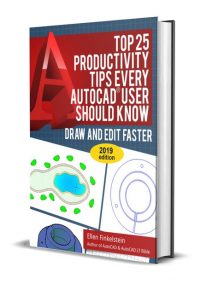I just finished teaching a 2-week AutoCAD class at the local University here (Maharishi University of Management). The course was part of the Sustainable Living undergraduate major program. It was a lot of fun and the students created amazing designs and fantastic drawings of those designs. Although the time was a little tight, they really […]
| |||||
AutoCAD’s surfaces have evolved over the years. First, you could add thickness to 2D objects. I’m not sure when that happened (let me know if you do), but it was in the mid-1980s, perhaps around Release 2.6. This is still the only type of 3D objects that AutoCAD LT can create. Later (again, I’m not […] One of the new features in AutoCAD 2008 is data extraction. This might make you think of block attributes and data connectivity, but it combines features of both. It’s both simple and powerful. You start with the new DATAEXTRACTION command, or by starting the TABLE command and choosing the From Object Data in the […] Do you need to know which objects are on which layers? Count your layers? Hide objects on other layers? Layer Walk (the LAYWALK) command does all this and more. It was once part of Express Tools, but has become part of core AutoCAD. Layer Walk is quite a powerhouse and pulls together capabilities from several […] Jack Foster contributed a menu item that makes sure a layer is on, thawed, unlocked and exists — in other words, that you can use it. He says, “When working on a drawing that other users have worked on, you may find that the layer you need is off or frozen. Even if the layer […] You can modify more than one layer at a time. In the Layer Properties Manager dialog box (click Layers on the Object Properties toolbar) right-click and choose Select All or Clear All. Choose a range of layers by clicking the first layer, holding down Shift and clicking the last in the range. Choose multiple individual […] You can use fields (AutoCAD 2005 and later) to create automatic labels that provide information about objects. I’ve covered aspects of this topic before. In “Tutorial: Display the area of an enclosed figure,” I show how to use fields to create a label that displays an area. In “Tutorial: Create attributes,” I mention that you […] Since AutoCAD 2009, you can record macros for later use. You can include requests for user input and messages to make the macro work interactively. When you save a macro, it has an ACTM filename extension. You’ll find it in your Support\Actions folder of your AutoCAD installation. You can share ACTM files with others. Start […] Question: B.N. asks how he can get his AutoLISP routines from an earlier release into AutoCAD 2007 so that they’re always loaded and ready to go. Answer: An easy way is to type the AutoLISP routines in a file and save it as anything.lsp. Then choose Tools> AutoLISP> Load Application. Browse to anything.lsp and drag […] A workspace defines your user interface — which toolbars, menus, and palettes (including the command window) appear, and where. Workspaces are a great feature because you can save multiple workspaces to reduce the time you spend fussing with these objects — opening them, closing them, and moving them around. AutoCAD comes with default workspaces and […] | |||||
Copyright © AutoCAD Tips Blog 2020 - All Rights Reserved Privacy, Refund, and Other Legal Stuff Important: While we don't collect cookies, some of our 3rd-party services (such as PayPal and WordPress) do, to give you a safer and better browsing experience. Read about how we use cookies and keep your personal information secure by reading our Privacy Policy here. | |||||

 Instagram
Instagram LinkedIn
LinkedIn Facebook
Facebook 